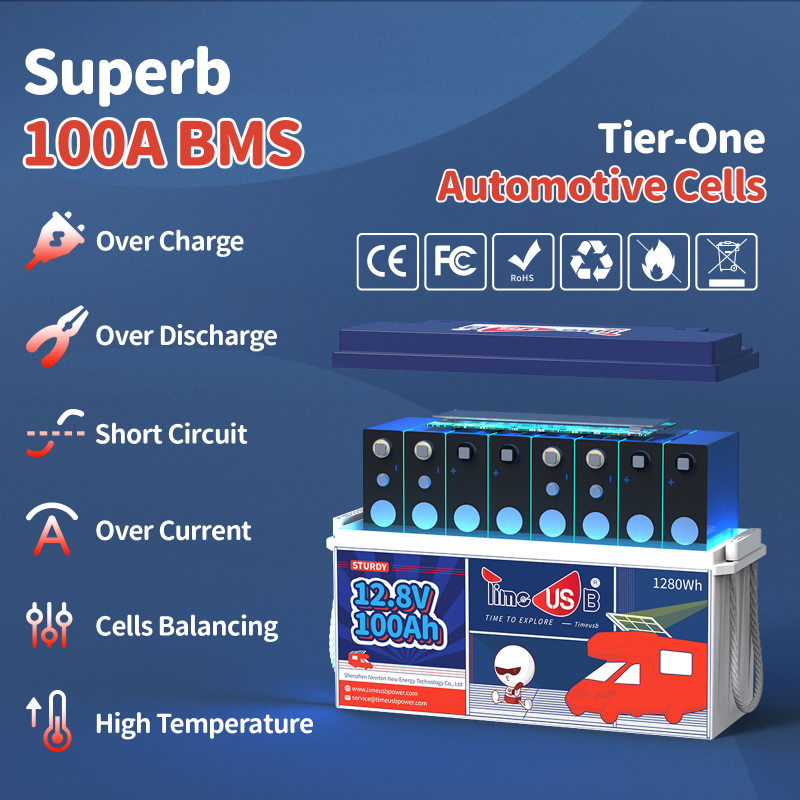How to Properly Store Your LiFePO4 Batteries to Maximize the Lifespan

LiFePO4 batteries have gained immense popularity due to their high energy density and long cycle life. However, to truly harness the full potential of these batteries, proper storage is crucial. In this article, we will explore the art of storing LiFePO4 batteries, highlighting essential factors, preparation steps, maintenance tips, and expert advice for long-term storage.
Have a view on Timeusb hot-sale and second-hand series to get your best budget LiFePO4 lithium batteries!
The Importance of Proper LiFePO4 Battery Storage
Unlike lithium-ion batteries, LiFePO4 batteries, which use stable iron compounds, are less prone to generating hazardous gases or exploding. However, they still require careful storage due to their significant investment cost.
Some LiFePO4 batteries come with a built-in protection mechanism like battery management system (BMS), making storage safer.

However, it is important to note that this protection circuit should not be used when storing batteries in a discharged state. The protection circuit is only effective for batteries that are charged to a minimum of 40% to 50%.
Store LiFePO4 Battery for Long Term: Disconnecting LiFePO4 Batteries Before Storage
When storing LiFePO4 batteries for long term, it is important to take certain steps to ensure their longevity and performance. One recommendation is to physically disconnect the main positive and negative wires from the batteries to prevent any power draw during storage. This will help preserve the battery charge and ensure that you have plenty of power when you use the batteries again.
LiFePO4 batteries have a low self-discharge rate of 1-3% per month. To minimize the rate of discharge, it is advisable to disconnect all power draw from the batteries.
When storing LiFePO4 batteries, it is important to store them with a state of charge (SOC) of 50% or higher.
To maintain the health and performance of LiFePO4 batteries during long-term storage exceeding three months, it is advisable to perform a charging and discharging cycle every three months. This practice will help keep the battery in optimal operating condition when it is eventually removed for use.
It is also important to use a lithium charger specifically designed for LiFePO4 batteries, as using chargers meant for other battery chemistries may not provide optimal charging and could potentially damage the batteries. By following these guidelines, you can ensure the longevity and performance of your LiFePO4 batteries during storage. Learn more on how to charge LiFePO4 batteries.

How to Store LiFePO4 Battery for Short Time
To ensure optimal storage conditions for LiFePO4 batteries, it is important to keep them in a dry place and prevent any leakage or corrosive gases from entering. The recommended temperature range for storage is -20 ℃ to 35 ℃ (-4 °F to 95 °F). Deviating from this range can result in rust or liquid leakage, ultimately reducing battery life or causing permanent failure.
The Temperature to Store LiFePO4 Lithium Battery
The battery can be operated at a temperature of -20℃ to 60℃ (-4℉ to 140℉)
For storage up to 3 months, the temperature range should be 10 to 35°C (50 to 95 °F).
It is crucial to store lithium batteries indoors during the off-season to minimize exposure to extreme temperatures. Additionally, it is recommended to store LiFePO4 batteries with a minimum state of charge (SOC) of 50% or higher.
If batteries are to be stored for long periods, it is advised to cycle the batteries at least once every 3 months. Lastly, it is important to note that discharged batteries should not be stored.

How To Store LiFePO4 Battery in Cold Winter: Indoor Storage is Key
When it comes to storing LiFePO4 batteries in cold weather, there is one word to remember: indoors. It is crucial to store lithium batteries in a temperature-controlled indoor environment to protect them from the detrimental effects of extreme cold.
LiFePO4 batteries, known for their excellent performance and longevity, can be quite sensitive to low temperatures. Exposing them to freezing temperatures can result in reduced capacity and potential damage to the internal chemistry. Therefore, finding a suitable storage location within a temperature range of 10 to 35°C (50 to 95 °F) becomes essential.
Ideally, a climate-controlled room or a garage with insulation can provide the optimal conditions for storing LiFePO4 batteries in cold weather. By keeping the batteries away from freezing temperatures, the risk of irreversible capacity loss or even complete failure can be significantly mitigated.
On cold winter days, when the temperature drops to extreme levels, having a battery with low-temperature protection becomes even more essential. The frigid temperatures can significantly impact battery performance, causing reduced capacity and potentially damaging the internal chemistry.
However, there are advanced batteries like the Timeusb 12V 140Ah LiFePO4 batterythat come equipped with a low-temperature cutting-off function, making them highly valuable in such conditions.
The Timeusb 12V 140Ah LiFePO4 battery stands out with its innovative low-temperature cutting-off function. This feature ensures that the battery automatically shuts down or enters a safe mode when the temperature falls below a certain threshold. By doing so, it protects the battery from operating outside its optimal temperature range, mitigating the risk of damage and extending its overall lifespan.
Other FAQs about Storing LiFePO4 Battery
1. How long can you store a LiFePO4 battery?
LiFePO4 batteries have a relatively long shelf life compared to other types of lithium batteries. When stored under ideal conditions, such as in a cool and dry environment with a charge level of around 50%, they can typically be stored for up to 1 to 2 years without significant degradation.
To maintain the battery's health, it is recommended to perform a charging and discharging cycle every three months for long-term storage exceeding three months. This helps ensure the battery remains in good operating condition when it is eventually removed for use.
2. Do I need to fully charge a LiFePO4 battery before storage?
No. For optimal storage of a LiFePO4 battery, it is generally recommended to store it with a state of charge (SOC) of around 50%.
This level of charge helps prevent excessive self-discharge during storage while still providing enough energy to keep the battery in a stable condition. Maintaining a SOC of around 50% is a good practice to ensure the battery remains in good condition during storage.
3. Can I leave a LiFePO4 battery connected to a device while it's in storage?
It is generally recommended to disconnect the LiFePO4 battery from any devices or equipment before storing it for an extended period. Leaving it connected could result in a slow discharge over time, especially if the device has a standby power draw. Therefore, it's best to disconnect the battery to preserve its charge.
4. Do I need to charge the LiFePO4 battery before using it after storage?
If the LiFePO4 battery has been stored for an extended period, it's advisable to recharge it before using it again. This ensures that the battery is at its optimal capacity and performance level. Following the manufacturer's guidelines for charging procedures will help prolong the battery's lifespan.
Conclusion
Proper storage of LiFePO4 batteries is essential to maximize their lifespan and maintain their performance. By following the recommended guidelines, such as disconnecting the batteries, storing them with a sufficient state of charge, and maintaining appropriate temperature conditions, you can ensure the longevity of your LiFePO4 batteries.
Remember to always refer to the manufacturer's instructions for specific storage recommendations tailored to your LiFePO4 battery. By taking proper care during storage, you can extend the lifespan of your LiFePO4 batteries and ensure reliable performance when you need them.
Timeusb provides grad-A cell LiFePO4 battery and chargers, if you have any questions, please contact service@timeusbpower.com.


![[Full Guide] The Comprehensive Guide to LiFePO4 Battery Life](http://www.timeusbpower.com/cdn/shop/articles/The_Comprehensive_Guide_to_LiFePO4_Battery_Life_757d2749-9468-4739-ac83-0960c27749b0.jpg?v=1722918256&width=1080)
